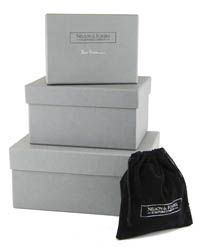Lion Bronze Sculptures
-
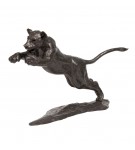
Bronze Lion Sculpture: Large Leaping Lioness by Jonathan Sanders
-
Edition:150
-
Size in cm:30w x 18h x11d cm
Including VAT: $1,289.83 Excluding VAT: $1,074.87 -
-
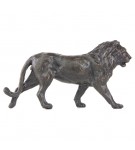
Bronze Lion Sculpture: Walking Lion by Sue Maclaurin
-
Edition:250
-
Size in cm:21w x 12h x 5d cm
Including VAT: $820.80 Excluding VAT: $684.00 -
-
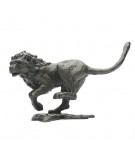
Bronze Lion Sculpture: Hunting Lion by Jonathan Sanders
-
Edition:250
-
Size in cm:19w x 10h x 9d cm
Including VAT: $544.90 Excluding VAT: $454.09 -
-
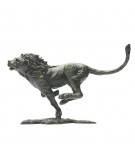
Bronze Lion Sculpture: Running Lion by Jonathan Sanders
-
Edition:250
-
Size in cm:20w x 12h x 7d cm
Including VAT: $544.90 Excluding VAT: $454.09 -
-
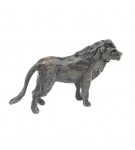
Bronze Lion Sculpture: Lion Maquette by Jonathan Sanders
-
Edition:500
-
Size in cm:7.5w x 5h x 3d cm
Including VAT: $144.85 Excluding VAT: $120.71 -
Bronze Lion sculptures – magnificent depictions of the Kings of Beasts
Jonathan Sanders has spent many, many hours watching lions in their natural African habitat, gaining a keen understanding of their particular physiology as well as their movement and social interactions with the pride.
His first bronze lion sculpture was the magnificent Large Leaping Lioness. As the females of the pride are responsible for eighty five percent of the hunting, Jonathan chose to capture a lioness at full stretch in the moments before she reaches her unfortunate prey. The size of this sculpture allowed Jonathan to depict in detail every straining muscle and razor sharp nerve as the lioness leaps towards her quarry and it is a truly magnificent piece.
We then received requests for collectors for Jonathan to sculpt male lions in a slightly smaller size. In June 2013 we unveiled Hunting Lion and Running Lion, as well as their delicate quarry, Leaping Impala. Both lions look wonderful in their own right and also complement each other beautifully when displayed together, with or without something tasty to chase!
The imagery of lions throughout history
Since the ice age, images of lions have been used by humans to symbolise ideas of protection and supremacy.
In Ancient Egypt, the sphinx was a representation of the Pharaoh with a lioness’s body and both Ancient Egyptian and African cultures returned time and again to stories and images of the lioness as a fierce hunter, representative of the warriors and protectors of society.
Lions were also used as symbols of personal and royal power through ancient history and across the globe including by the Mesopotamians, the Babylonians, Assyrians, Persians and in early Islamic cultures.
The present national emblem of India shows four lions standing back to back and this originated as a sculpture created by Emperor Ashoka who ruled India from 269BC.
The lion also appears throughout Greek mythology, including most famously as one of the twelve tasks assigned to Heracles. In Aesop’s fable of the story of Androcles, the hero, a runaway slave, pulls a thorn from a lion's paw; and when he is later thrown to the lions as punishment for escaping, the lion recognizes him once again and refuses to kill him. According to the Book of Genesis of the Hebrew Bible, the Israelite Tribe of Judah had the Lion of Judah as its symbol.
The characteristic of the lion as the kings of beasts can be attributed to the influence of the Physiologus, an early Christian book about animal symbolism which spread into many cultures and greatly influenced Western culture. Written in the 2nd century AD, the book was translated into Latin in about 400 AD, next into Ethiopic and Syriac, then into many European and Middle Eastern languages. It retained its influence over ideas of the "meaning" of animals in Europe for over a thousand years. Medieval poetical literature is full of allusions that can be traced back to the Physiologus tradition and the text also exerted great influence on the symbolism of medieval ecclesiastical art.
Many images from ancient times depict lionesses as fierce warriors protecting their culture. Since in certain views lionesses seem to have a ruff, often the only clue to this difference between the genders is the lack of a mane. When no mane is apparent, the image often is described as a panther or leopard among cultures without familiarity with the nature of lion social organisation and hunting strategies for prides (it is the lionesses that do the majority of the hunting in prides).
Images of lions appears on many flags, coats of arms and emblems and they are recurring symbols in the coat of arms of royalty and chivalry, particularly in the UK.
Regarded as the king of beasts, as a heraldic emblem the lion represents strength, valour, bravery and royalty and is a heraldic supporter of the coat of arms for the English monarch.
The Lion as a protective symbol in Feng Shui
Chinese Guardian Lions are commonly found representations of the lion in pre-modern China. Also called Imperial Guardian Lions, or ‘Foo Dogs’ in the West (which translates as prosperity), they are known in Chinese as “Shi”.
Although not indigenous to China, lions and their surrounding folklore were brought to the country by traders and priests. The Chinese word for lion, “Shi” is very similar to the Persian name “Shiar”.
Buddhists first introduced lions to China around 200BC as the protector of dharma (loosely translated as a righteous way of living). The Chinese adopted the imagery as an appropriately regal beast to guard the emperor’s gates during the Han Dynasty (206BC- 220AD) and the practice was eventually adopted throughout China. Some of the best known guard the entrance to Beijing’s Forbidden City.
The presence of Guardian Lions outside Imperial palaces, government offices and the homes of high ranking members of society indicate the high financial and social status of the occupants.
Traditionally guardian lions were made of marble, granite or cast from bronze or iron.
Guardian Lions are usually depicted in pairs, a representation of yin and yang, with the female representing yin and the male yang. The male would be shown resting a paw on a ball, asserting his dominance over the rest of the world, while the female would be shown with a cub, depicting nurture.
Guardian Lions are common today outside hotels, supermarkets and restaurants, both in China and overseas in areas with a large Chinese populations. In decoration, they can also be seen in small adornments around the world, including on door knockers, decorated china and pottery. Lions may depicted in may fashions, from very fierce to serene.




